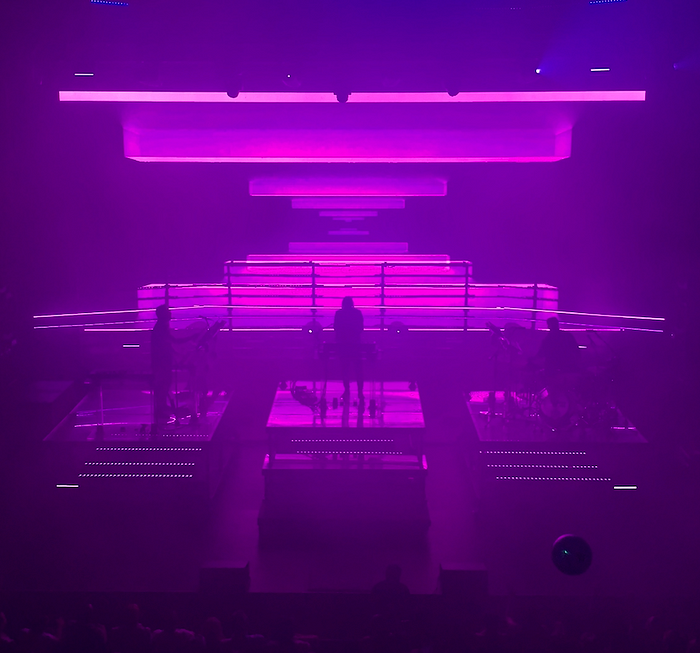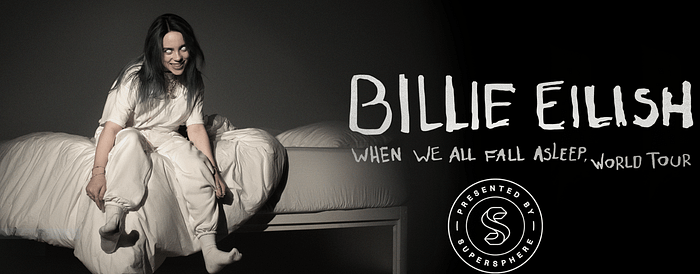An Update on Concerts in VR — Progress, But Not Perfection

With advancements in virtual reality (VR) headsets and an influx of virtual live music experiences recently, it’s time for another look at what is working well and what can be improved. I first commented on the state of virtual concerts in 2016 and then again a year later. This year has seen significant growth in virtual concerts, highlighted by the ten+ million people that attended the Marshmello concert in Fortnite, and also influenced by new versions of VR headset hardware that are affordable and easier to use.
A few comments before diving in. First of all, it is thrilling to see more people participating in VR concert experiences. While looking for a place to “sit” at a recent Billie Eilish event in Oculus Venues, I realized there were almost a dozen friends watching her perform at the same time that I was. That is just plain exciting! Experiencing music in a virtual space with friends is nothing short of magic.
It is important to understand there is a distinction between a virtual concert and a concert in VR. A virtual concert is an amorphous term, which could mean anything from a concert created in virtual space to one that is viewed in virtual space to one that is simply viewed remotely, often using streaming web services. A concert in VR refers to viewing the event in a VR headset. VR concerts have a massively higher level of presence because the fan is immersed in the experience and surrounded by spatial content (whether computer generated or 360 video). My comments today are focused on VR concerts, though some of the companies mentioned below below provide both methods of viewing. Of note — I used the Oculus Quest headset for most experiences and Oculus Rift for Wave.
Fortunately, many benefits of virtual concerts exist across all platforms:
- Seeing an artist you love without having to leave your home.
- Not getting stuck standing behind tall people.
- The ability to adjust the volume as loud, or low, as desired.
- No waiting in line for the restroom.
- Avoiding anyone talking loudly.
- Having incredible views of the stage that aren’t possible at most shows.
However, there is still a lot of opportunity to make these experiences better — more immersive, more engaging, more fun.
Ok, let’s break it down by event.

Billie Eilish — in Oculus Venues presented by Supersphere.
First, well done by Oculus to start the experience with an overview of how to behave in VR, and to reinforce that message upon re-entry. It’s unfortunate that people need those reminders, but at this point we do. There are also guidelines on how to report offensive behavior and to get back to solo mode. Extremely useful for any social VR experience.
More on the plus side- it is great to have the option to either watch the show solo or to ‘join the crowd’, which means to join other avatars (people) in the oculus venue. Sometimes I want to focus on the music, and sometimes I want to be social. It’s nice have the ability to do both.
A few technical glitches with the social component made it less than ideal, but I’m still optimistic. Using a menu, it is easy to see who you know that is in the venue and how you are connected to them (via facebook friend, group, city, etc). The concept of moving close to someone that you know is great. However, when I did that I continued to get a message that I needed to sit down…and I was already sitting. Plus, the message wouldn’t go away unless I exited the event.
Speaking of standing and sitting — in this experience it wasn’t possible to do both. It’s a concert. It’s Billie Eilish. We need the ability to dance, even virtually. And let’s face it, some people are more comfortable dancing on their own (and in the privacy of their own home).
Other challenges: the venue holds a limited number of participants, so you may not be in the same virtual venue as your friends. As a workaround, I would exit Venues and and reenter to try to find my friends. It would be interesting to have a “VIP box” option so that a group of friends could get together and watch it in a private room- that would also enable a more social integration since that group could have conversations without disturbing others.
Most disappointingly, the audio. Sigh. The event is all about music. Please make the audio better. Of all the virtual music experiences I’ve seen (and there have been many) this was once of the worst in terms of audio quality. Distortion, limited range, low volume. I’ll talk more about audio later, but let’s just say there is a LOT of room for improvement here — this wasn’t even close to being an immersive audio experience.
On visuals. The location of the cameras and switching between views was okay, but it can be significantly better. There are some experiences that allow the viewer to control the movement (more on that later too). Billie’s image was surprisingly grainy, but at least it was streaming consistently (not always a given). It was interesting to be able to see her perform with an injury on stage. She was wearing a cast and it was perticularly impressive to see her movement— without having the vantage point of the VR cameras, that wouldn’t have been as viewable.
Though it was fun to be able to dress my avatar in merch, I couldn’t find a way to take photo or video. We need to be able to share these virtual experiences IRL. Integration with Instagram, Oculus gallery, or some other form of Facebook must be imminent.
As I exited the venue for the last time there was an announcement for an upcoming H.E.R. concert. When I clicked for more information there was a message that said that I seemed lost and could they take me home. Yes, just get me home. I love Billie Eilish and have seen her perform twice, but I can’t listen to that audio quality anymore. On the plus side, Oculus sent a survey out after the event for feedback. I hope they integrate our feedback.

Shallou — Next VR.
Let’s contrast this with the Shallou show I saw recently in Next VR. As I mentioned earlier, my first VR concert was using Next VR. It has been interesting to see them change over time — for the better.
In this latest event with Shallou, the performers looked much more realistic (they used to be too small), the resolution was higher and the audio quality was beautiful. Unfortunately the audio still isn’t spatial. I look forward to the day when we turn our heads (or our location changes) the audio shifts from ear to ear as it does in real life.
There was a new feature I hadn’t experienced before that was surprisingly useful. By pulling controller trigger you could zoom out quickly. I used it a few times- especially when I was feeling too close to the stage. That’s right, sometimes it felt a bit too close to the band. What a fantastic problem to have. In general there are 1–2 stage views, a front of stage view and a soundboard view. For me, the diversity of view is appealing and NextVR is quite good at shifting between camera angles in a way that feels natural with the music.
There is no social option with Next VR, but it is a vastly more pleasurable and immersive experience than watching a youtube video.
The Kooks — MelodyVR.
I’d been in Melody VR before, but there are fewer artists that interest me and the experiences haven’t inspiring enough to return frequently. That said, I did recently watch the Kooks. This was a recorded experience in a small room without an audience. The sound was vibrant, but not spatial. For a music nerd like me it is always interesting to see a band play up close, but the wow factor wasn’t there. That said, I recommend giving MelodyVR a try. They do have a lot of performances available and there are a wide range of artists. There is a cost to these experiences, but you can purchase per event and often per song.

Lindsey Stirling — Wave.
Finally, hundreds of thousands watched as Lindsay Sterling premiered her new album Artemis via Wave (via VR or the web using Twitch, Facebook or YouTube). Unfortunately I wasn’t able to join this event in VR, but the video is stunning. After being in Wave’s Imogen Heap performance earlier this year, I can imagine what it was like. The experience transports you from reality to a place that does not exist on earth. Wave goes beyond 360/180 video by using facial and body tracking to create avatars of the artists that can ultimately manipulate light and visuals that flow with the music. Sound amazing? It is. I won’t miss the next one. Oh, and it’s a social experience. Bring your friends.
All in all, there continues to be a vast opportunity in the VR concert market — and VR music experiences in general, but that’s a topic for another time. In summary, social experiences are improving as is the level of immersion, but visual quality is inconsistent and audio still isn’t truly spatial. As an incremental improvement, we should expect audio and video quality to continue to improve year after year, enhanced by the roll out of 5G and continued improvements in headsets. I look forward to meeting some of you at a virtual concert and would love to hear about your own VR music experiences.







